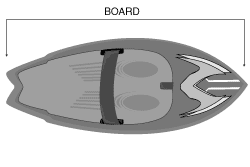Kneeboards
Whether you're a recreational or competitive rider, our guide has information to help you choose a board.
How To Buy A Kneeboard
If you are looking for a unique watersport that is similar to water skiing, and just as thrilling, kneeboarding is for you. Kneeboarding offers all new challenges and thrills, but having the right equipment for your size and ability is essential to enjoy the sport.
Choosing the Right Kneeboard
Choosing between the two basic types of kneeboards offered by top manufacturers depends primarily on what type of kneeboarding you plan to do.
Types of Kneeboards
- Recreational
- Most recreational kneeboarders use a rotomolded board, which is widely available and less expensive than high-tech models
- The soft, wide edges of rotomolded boards are best suited for beginners and boarders just out for a good ride
- The design allows for smooth turning and good control for even the novice kneeboarder
- The boards are relatively thick and very buoyant, so they help act as a flotation device after a spill
- Some rotomolded boards offer fins to help make turning easier
- Competitive
- Compression-molded boards offer more performance and durability for the advanced kneeboarder
- These are thinner, lighter and have sharper edges to allow quicker turning and tricks
- Compression-molded boards are not as buoyant as rotomolded versions, which allows advanced users to utilize deep-water starts
Kneeboard Styles
Whether you are a beginner or advanced, there are two general styles of kneeboards, and the one you choose depends on what you are planning to do out on the water.
- Trick board
- Features a rounded bottom and rounded edges to make it easier to perform tricks.
- Slalom board
- Designed for the specific use of slalom boarding
- Has sharper edges to allow for better turning and holding the edge through the turn
Kneeboard Construction
There are various parts of every kneeboard that affect its performance.
- Materials
- Kneeboards are comprised of generally the same materials as water ski's
- A polyurethane or foam core is wrapped by a fiberglass or fiberglass/graphite (on advanced boards) composite exterior
- Rocker
- This is the measurement of the curve on the bottom of the kneeboard
- The higher the rocker number, the easier to turn. The lower the rocker, the faster it goes.
- Most kneeboards have a rocker of 5-6 centimeters
- Fins
- These are located on the bottom of the kneeboard to make it easier to steer
- Usually made of hard plastic and a fiberglass composite.

Choosing the Right Rope
Kneeboarders, require a stiffer rope than water skiers to help perform tricks. A tighter, stiffer rope that does not stretch helps you get more air and be able to pull yourself through flips and spins.
Low stretch
- Low stretch ropes are generally constructed of polyethylene or a polyethylene blend
- These generally stretch around one percent in length when under a normal kneeboarding load
No-stretch
- No-stretch ropes are constructed using a materal called Spectra
- Spectra® rope is very strong and has almost no elastic properties.
- They stretch less than half a percent when under a normal load
Multi-purpose
- If you mainly kneeboard and are trying to improve your skills and learn tricks, the spectra rope is your best bet
- If you spend equal amounts of time skiing and kneeboarding and you are an occasional or recreational user, a low-stretch rope will do the job. This gives you some stretch for recreational water skiing, but also offers enough stiffness to pull against when kneeboarding.
Rope length
- Kneeboard ropes vary in length, but most are 60 to 70 feet long
Handles
- Kneeboard handles tend to be more specialized than water-ski handles because they offer more features that make tricks and aerial maneuvers easier
- Most kneeboard handles have a wider grip than water ski handles
- Kneeboard handles commonly have grips that are 13-15" wide, whereas ski handles are generally 11-12" wide
- The increased grip width makes it easier to perform tricks requiring the handle to be passed behind the rider's back
- Kneeboard handles typically have a feature that makes spinning tricks easier. This may come in the form of a rope braid or the newer "launch" handles that offer a second, smaller handle grip built into the rope for a stronger hold.
- Most kneeboard handles have neoprene foam floats on them to keep the handle floating
- Kneeboarders ride at fairly slow speed, much slower than water skiers, allowing foam floats to be built onto the handle without having a problem with the water ripping them off